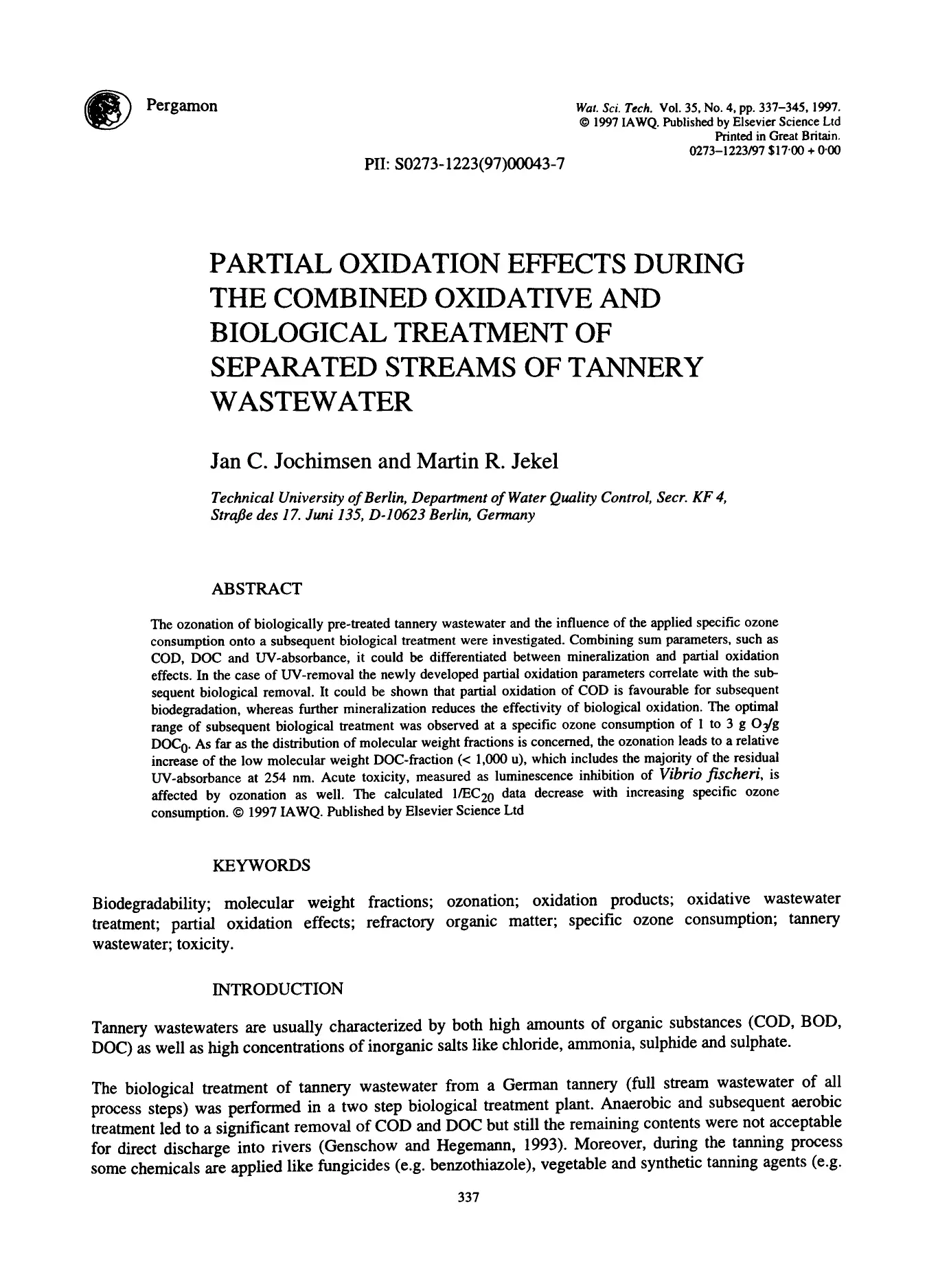Leachate Treatment By The Combination Of Photochemical Oxidation With Biological Process
Strict monitoring of leachates is required according to legislative regulation in terms of efficient elimination of refractory pollutants. Particularly, in wastewater purification processes which depend on the characteristics of the components and require specific discharge system, intensive studies have been carried out to improve the efficiency for decreasing chemical oxygen demand (COD) and adsorptive organic halogen (AOX) as well as ammonium/nitrogen contents. For this purpose, the biological treatment is generally accepted as the economically most efficient method. Especially, the activated sludge process is applicable for the removal of the biodegradable organics and inorganic N-compounds, where high sludge contents and intensive air ventilation are necessary.
Leachate Treatment By The Combination Of Photochemical Oxidation With Biological Process
Strict monitoring of leachates is required according to legislative regulation in terms of efficient elimination of refractory pollutants. Particularly, in wastewater purification processes which depend on the characteristics of the components and require specific discharge system, intensive studies have been carried out to improve the efficiency for decreasing chemical oxygen demand (COD) and adsorptive organic halogen (AOX) as well as ammonium/nitrogen contents. For this purpose, the biological treatment is generally accepted as the economically most efficient method. Especially, the activated sludge process is applicable for the removal of the biodegradable organics and inorganic N-compounds, where high sludge contents and intensive air ventilation are necessary.
Partial Oxidation Effects During The Combined Oxidative And Biological Treatment Of Separated Streams Of Tannery Wastewater
The ozonation of biologically pre-treated tannery wastewater and the influence of the applied specific ozone consumption onto a subsequent biological treatment were investigated.
Partial Oxidation Effects During The Combined Oxidative And Biological Treatment Of Separated Streams Of Tannery Wastewater
The ozonation of biologically pre-treated tannery wastewater and the influence of the applied specific ozone consumption onto a subsequent biological treatment were investigated.
Performance Of Combined Process Of Anoxic Baffled Reactor-Biological Contact Oxidation Treating Printing And Dyeing Wastewater
A study of the treatment of printing and dyeing wastewater was carried out using the combined process of anoxic baffled reactor-biological contact oxidation. The results showed the pH ascended continuously and the oxidation-reduction potential dropped gradually from compartment 1–6 in ABR. When hydraulic retention time was 12 h, color removal efficiency was 92% and the color of effluent of ABR could satisfy the professional emission standard (grade-1) of textile and dyeing industry of China. dyeing industry of China.
Performance Of Combined Process Of Anoxic Baffled Reactor-Biological Contact Oxidation Treating Printing And Dyeing Wastewater
A study of the treatment of printing and dyeing wastewater was carried out using the combined process of anoxic baffled reactor-biological contact oxidation. The results showed the pH ascended continuously and the oxidation-reduction potential dropped gradually from compartment 1–6 in ABR. When hydraulic retention time was 12 h, color removal efficiency was 92% and the color of effluent of ABR could satisfy the professional emission standard (grade-1) of textile and dyeing industry of China. dyeing industry of China.
Pervaporation-Biological Oxidation Hybrid Process For Removal Of Volatile Organic Compounds From Wastewaters
A new pervaporation-biological oxidation hybrid process for the treatment of wastewaters containing volatile organic compounds (VOCs) has been investigated. The process combines pervaporation using a sweep gas with absorption and biological degradation of the permeate VOCs. A model system with monochlorobenzene (MCB) as the VOC and Pseudomonas JS150 as the degrading microorganism was used for the study.
Pervaporation-Biological Oxidation Hybrid Process For Removal Of Volatile Organic Compounds From Wastewaters
A new pervaporation-biological oxidation hybrid process for the treatment of wastewaters containing volatile organic compounds (VOCs) has been investigated. The process combines pervaporation using a sweep gas with absorption and biological degradation of the permeate VOCs. A model system with monochlorobenzene (MCB) as the VOC and Pseudomonas JS150 as the degrading microorganism was used for the study.
Pilot Study On The Advanced Treatment Of Landfill Leachate Using A Combined Coagulation, Fenton Oxidation And Biological Aerated Filter Process
Mature landfill leachate is typically non-biodegradable. A combination process was developed that includes coagulation, Fenton oxidation, and biological aerated filtering to treat biologically-produced effluent. In this process, coagulation and Fenton oxidation were applied in order to reduce chemical oxygen demand (COD) organic load, and enhance biodegradability.
Pilot Study On The Advanced Treatment Of Landfill Leachate Using A Combined Coagulation, Fenton Oxidation And Biological Aerated Filter Process
Mature landfill leachate is typically non-biodegradable. A combination process was developed that includes coagulation, Fenton oxidation, and biological aerated filtering to treat biologically-produced effluent. In this process, coagulation and Fenton oxidation were applied in order to reduce chemical oxygen demand (COD) organic load, and enhance biodegradability.










